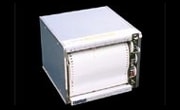 |
 |
 |
 |
HP's first-ever acquisition was Pasadena, California-based F.L. Moseley in 1958. |
HP's Moseley division produced plotters and other graphic recording
instruments that automated the labor-intensive process of plotting
data by hand.
Strip chart recorders were used primarily in industrial applications
where there was a need for continuous recording of such data as
aircraft testing (wing stress), oil well exploration (seismic logs)
and satellite solar converters (voltage output).
The Moseley 680 strip chart recorder used a capillary-fed ink pen
supplied from a replaceable ink cartridge or by a stylus on pressure-sensitive
paper. Eight chart speeds and 10 calibrated input voltage ranges
were selected from the front panel. It was constructed in modular
form, for rack mounting singly or in pairs or for tabletop operation.
The Moseley technology was pioneering in the field of two-axis
graphic recording instruments.
In the late 1920s, Francis L. Moseley, tired of the tedious task
of writing down columns of data, plotting graphs and drawing smooth
curves, conceived the idea of an x-y recorder using standard-size
graph paper. An x-y recorder is an electromechanical device that
produces permanent graphical displays of two input variables as
they relate to each other.
In 1951, the F.L. Moseley Co. was formed in a California garage
to manufacture the first commercially available models of the x-y
recorder, called the Autograf line. For scientists and engineers
everywhere, the Moseley x-y recorder meant that a means for automatically
recording the relationship between two variables was finally available.
Friction to heat, vibration to velocity, current to voltage—whatever the variables, the Autograf made it possible to trace them on chart
paper automatically, rather than tracking them by hand.
In 1958, HP acquired the Pasadena,
California-based F.L. Moseley, complementing its highly diversified
line of measuring and signal-generating instruments. The association
made it possible to further develop and improve the graphic recording
instruments, which by then had become a standard in the industry,
and to correlate uses and applications with many HP
products. |

